Change or No Change Question
When you enter an Item's Resolution, you will use the Change or No Change Question to record the outcome of your work.
What is it?
When you enter an Item's Resolution, you will likely see the question: "Did this result in a change?"
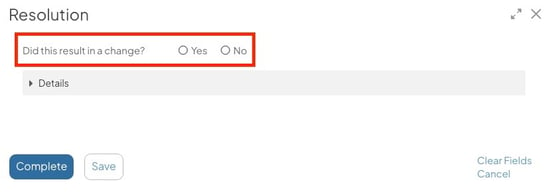
We call this the "Change or No Change" question. It helps you record the outcome of your improvement work.
Selecting "Yes" indicates your work had an Impact, which is a positive result. Selecting "No" indicates your work did not result in any notable outcome; this scenario is typically due to your team deciding not to implement the idea or project.
/Ofie/Ofie%20Profile%20Pic.png?width=50&height=50&name=Ofie%20Profile%20Pic.png) Pro Tip: A Template must have Resolution enabled for the Change or No Change question to appear. Contact your Customer Success Manager if you want to turn on this feature.
Pro Tip: A Template must have Resolution enabled for the Change or No Change question to appear. Contact your Customer Success Manager if you want to turn on this feature.
Why is it important?
Just because your work didn’t result in change doesn’t mean you shouldn’t complete it.
In KaiNexus, Complete Status shows the work moved through the entirety of its lifecycle. All Items should be completed, even if the team decided not to work on it.
Answering "Did this result in a change?" gives you the opportunity to complete an Item and specify whether or not it had a positive outcome, helping you record why certain ideas and projects were not implemented.
You can then run reports on all your improvement work and see the percentage of Items resulting in Change or No Change.
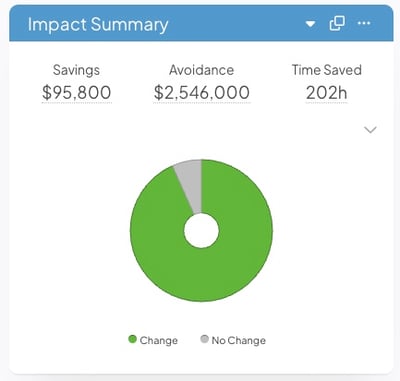
Image of an Impact Summary Report Card. It includes a pie chart that breaks down the percentage of Items that resulted in Change versus No Change.
Answering the Change or No Change Question
You will answer the Change or No Change question while filling out an Item's Resolution.
This support page will focus only on the Change or No Change question, but we recommend visiting our Complete an Item support page for a comprehensive overview of how to fill out a Resolution.
Responding "Yes"
When your improvement work results in a specific outcome or generates an Impact, you should respond "Yes" to the Change or No Change Question.
After you select "Yes," a list of Impacts will appear. Select the Impact that best matches the outcome your work generated.
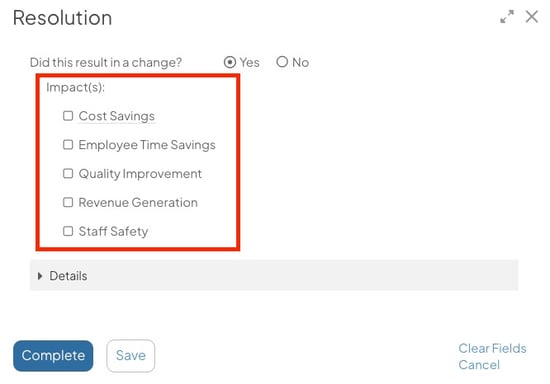
Impacts are split into two categories: Quantitative Impacts, such as Cost Savings and Revenue Generation, and Qualitative Impacts, such as Safety and Satisfaction.
/Ofie/Ofie%20Profile%20Pic.png?width=50&height=50&name=Ofie%20Profile%20Pic.png) Pro Tip: Follow this link if you have questions on recording information for an Impact.
Pro Tip: Follow this link if you have questions on recording information for an Impact.
Responding "No"
When your improvement work did not result in a specific outcome or closed before any work was performed, you should respond "No" to the Change or No Change Question.
After you select "No," a list of No Change Reasons will appear.
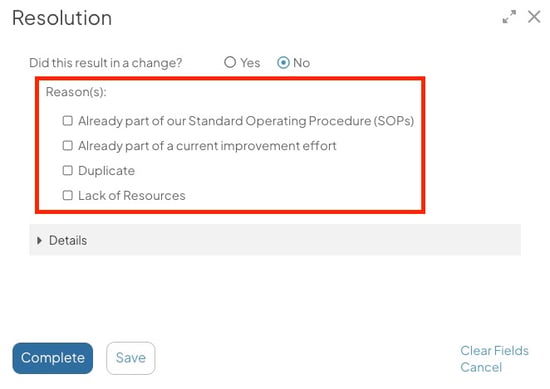
No Change Reasons explain why the improvement work did not have an Impact. Common examples of No Change Reasons are:
- Lack of resources
- Duplicate
- Already part of a current improvement effort
- Not a strategic priority
/Ofie/Ofie%20Profile%20Pic.png?width=50&height=50&name=Ofie%20Profile%20Pic.png) Pro Tip: Impact Types and No Change reasons are customizable by your organization. Different Templates can also have different Impact Types and No Change Reasons. Contact your Customer Success Manager if you want to update either one on a Template.
Pro Tip: Impact Types and No Change reasons are customizable by your organization. Different Templates can also have different Impact Types and No Change Reasons. Contact your Customer Success Manager if you want to update either one on a Template.
Selecting a Third Option
Sometimes you may not know whether your improvement work resulted in change. This could be because:
- You do not yet have any data on your work's outcome
- You are unsure how to categorize the outcome of your work
- The outcome of your work does not fit any Impact or No Change Reason
In these scenarios, you might not want to log any Impacts or No Change Reasons for your Item. Instead, you should use the Third Option.
A Third Option is an additional answer choice to the "Did this result in a change?" question. Your organization can rename the Third Option to anything, but by default, the Third Option will be called "Unknown."
When you select "Unknown," a list of Third Option Reasons will appear.
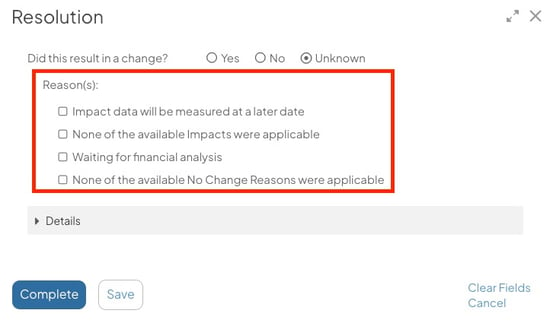
/Ofie/Ofie%20Profile%20Pic.png?width=50&height=50&name=Ofie%20Profile%20Pic.png) Warning: Not all Templates will have a Third Option for the Change or No Change Question. It must be enabled on the Template by your Customer Success Manager.
Warning: Not all Templates will have a Third Option for the Change or No Change Question. It must be enabled on the Template by your Customer Success Manager.
Third Option Reasons are explanations for why you couldn't accurately respond "Yes" or "No" to the "Did this result in a change?" question. Common examples of Third Option Reasons are:
- Impact data will be measured at a later date
- Unsure of which Impact to pick
- Waiting for financial analysis
- No Impacts accurately described the outcome of this improvement work
- None of the available No Change Reasons were applicable
Overall, you can use the Third Option to prevent inaccurate Impact data from being logged and give your workforce an opportunity to communicate when none of the existing Impacts or No Change Reasons reflect the outcome of their work.